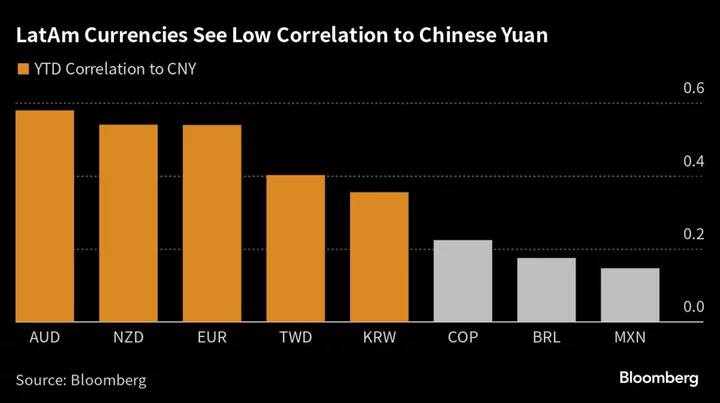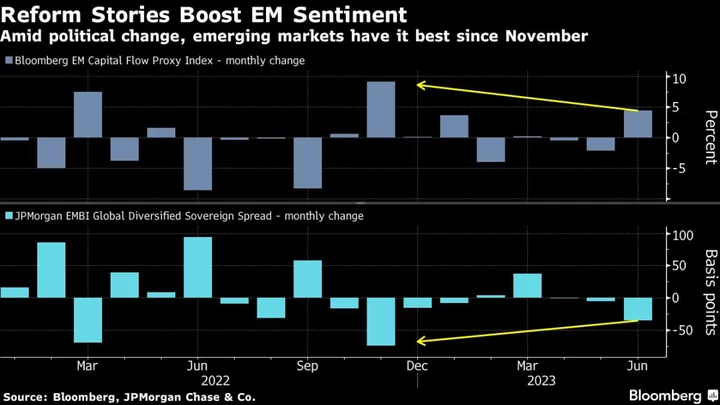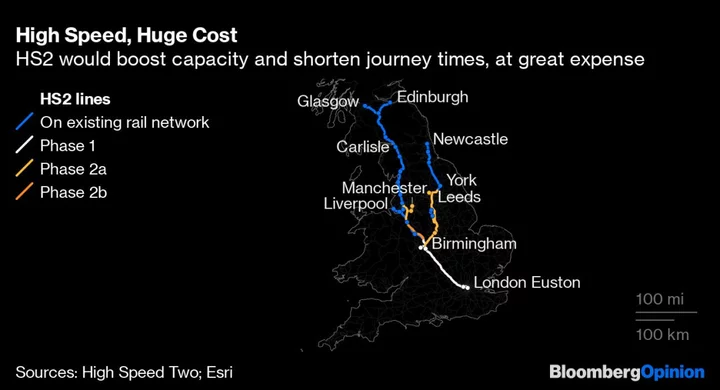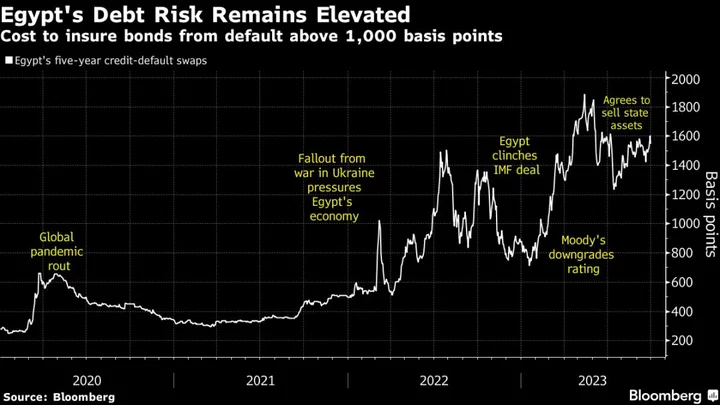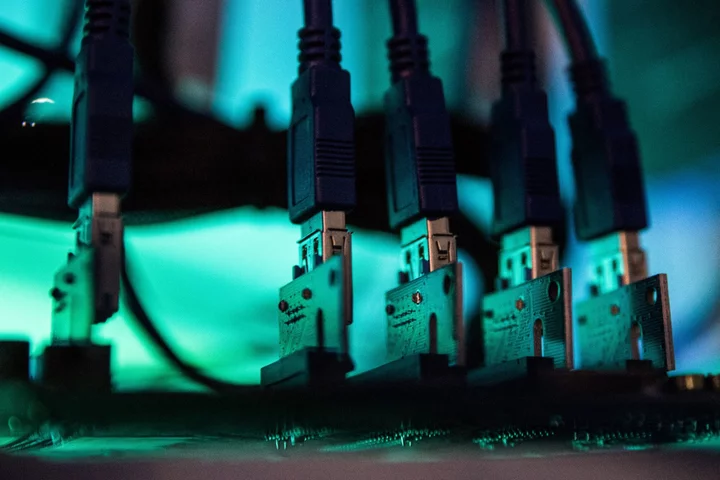For currency speculators around the world, the trade has long been a no-brainer: simply borrow yen, which costs nothing because of sub-zero interest rates in Japan, and then park the money anywhere yields are higher, earning a tidy profit from the difference.
But now, a surprising low-cost alternative to the Japanese currency has started to emerge — this time from China. In the past month, Invesco, Goldman Sachs, Citigroup and TD Securities all recommended the yuan as an attractive option for funding so-called carry trades as it weakens toward historical lows.
While the cost to borrow Chinese currency in overseas markets has jumped in recent days as policymakers in Beijing work hard to defend the currency and fend off speculators, proponents of the yuan carry trade are undeterred. They say their stance has as much to do with the diverging fortunes of Asia’s two largest economies as it does with cold, hard profits or diversifying risk.
Moribund for decades, a pickup in Japanese inflation — and tentative signs of a revival in growth — have fueled talk the Bank of Japan will finally end its seven-year-old policy of negative rates. For China, the trade underscores how far the once-mighty juggernaut has fallen. Heavy debt loads, a housing bust and fears of deflation have prompted the People’s Bank of China to slash its benchmark rate twice since June to a record-low 1.8%. Many expect more cuts to come — which will make the yuan even weaker and cheaper to borrow.
“If you think the BOJ is in play, then you get yen strength out of that and need to be careful, while the PBOC is still easing policy,” said Dirk Willer, head of global macro and emerging-markets strategy at Citigroup. A weak Chinese economy is “an important part of that trade.”
Carry On
This month, Willer’s team recommended clients sell yuan against a basket of currencies that includes the dollar and the euro.
There are plenty of caveats, of course. No one is suggesting the yen carry trade is dead or that speculators abandon the yen for the yuan. So far this year, funding purchases with the yen in Latin America — where benchmark rates are as high as 13.25% — has been particularly profitable. An equal-weighted basket of reais, and Colombian and Mexican pesos has gained 42%, easily surpassing the Nasdaq’s rally.
And the yuan is no sure bet as a funding currency. China has aggressively intervened to prop it up in overseas markets. State-owned banks have drained the supply of offshore yuan periodically to jack up funding costs and scare off speculators. On Wednesday, the cost of borrow yuan for three months briefly soared above 4%, the highest in five years.
Growth Concern
Friday’s retail and industrial production data in China showed the economy may be stabilizing. Economists surveyed by Bloomberg expect China to meet the government’s growth target of 5% this year, versus an expansion of 1.8% in Japan. The gap in growth between the two countries, while still sizable, has shrunk markedly. Back in 2021, it was twice as large.
“The PBOC has come in and they’ve made it very clear that they’re concerned,” said Jae Lee, a strategist at TCW Group. That raises the chances yuan-based carry trades can go the wrong way in the near term.
Central banks in Brazil, Mexico and Chile have also started to lower rates, reducing the “carry” (which is finance jargon for the return on an investment) on some of the most lucrative trades.
Despite the risks, a growing number of traders still see value in the yuan as a means to spread out the funding risk on their carry trades.
While yen carry trades boomed the past two years as just about every central bank outside Japan aggressively raised rates, the worry now is that the BOJ will join in, especially as inflation has topped its 2% target for over a year. Traders recently priced in expectations the bank will raise rates in January.
Yen Whipsaw
Yen fluctuations have become more pronounced as well, and Japanese officials have stepped up their jawboning when they perceive any excessive weakness — precisely what carry traders try to avoid in a funding currency.
“The yen whipsaw is something that’s really, really kind of preventing people from engaging” in Japan-based carry trades, said Simon Harvey, head of FX analysis at Monex Europe.
Instead of using yen, Goldman Sachs recommended funding purchases of reais and Colombian pesos with yuan. Strategists at TD also told clients to borrow yuan to buy Indian rupees, Mexican pesos and reais.
The rationale is straightforward. The PBOC will need to drop rates to rock-bottom levels to prop up the economy. That will reduce funding costs and weaken the currency — boosting yuan-based carry-trade profits along the way. In the local market, the yuan, which isn’t convertible and out of reach for most foreigners, recently fell to a 16-year low.
IRL
Carry trades are usually done using forwards — over-the-counter contracts between two parties to exchange one currency for another at a fixed rate and time in the future. In theory, carry trades shouldn’t really work. What you pick up in interest should be offset by what you lose in currency depreciation. But in real life, things are far messier, meaning there’s still money to be made.
Banco de Investimento Global SA’s Ricardo Seabra is among those who scored big. His BiG Diversified Macro Fund has returned 12% this year through August, versus a roughly 1% loss for its benchmark.
Seabra has been rotating funding currencies throughout the year and added the yuan to the mix over the past two months as China deteriorated. It’s now one of his two main funding currencies, along with the yen.
He isn’t too worried about the PBOC’s recent actions because he expects the bank will slowly let the yuan depreciate over time. And ultimately, what’s more important is nailing the long positions.
Of late, those have been currencies like the Brazilian real. Currently, three-month forwards yield 10.8% for reais. For Mexican pesos, it’s 11.7%. Since it costs 4% to borrow offshore yuan to fund the transaction, that implies an annualized return of roughly 7%, if exchange rates remain stable. (That might not sound much, but since these trades are almost always highly leveraged, actual profits can be many times greater.)
Juicy Yields
“We like these juicy real yields,” Seabra said.
Ironically, Beijing’s intervention in the offshore yuan, and the fact it’s closely managed to keep the price near its onshore counterpart, could even be a plus by damping volatility and making profits more predictable. The yuan’s three-month implied volatility stands at 5.6, the third-lowest among major currencies, versus 9.3 for the yen.
“We still see the yuan as an attractive funding currency, given its low yields, low volatility and moderately expensive valuations,” said Alessio de Longis, head of investments at Invesco Solutions.

